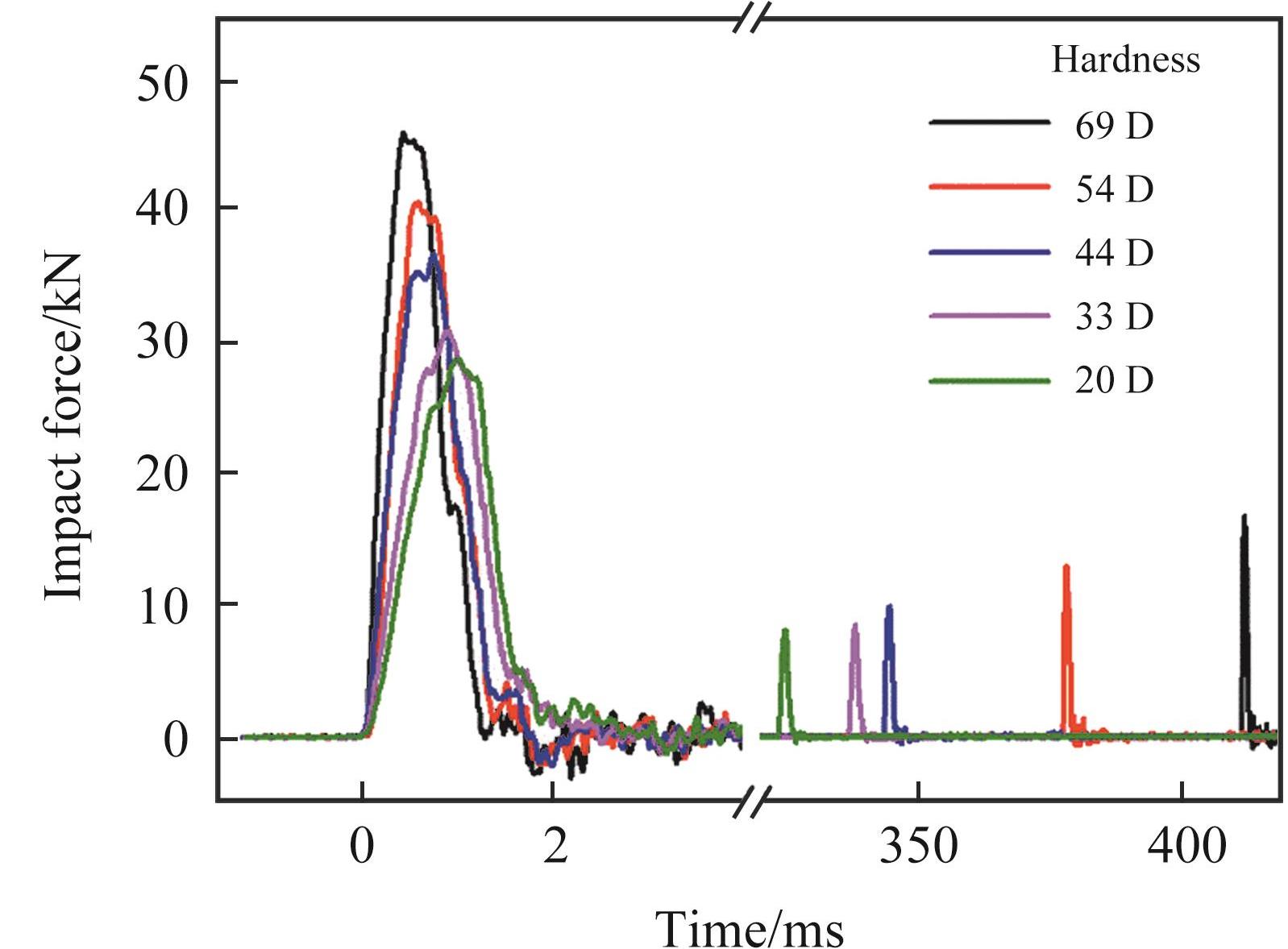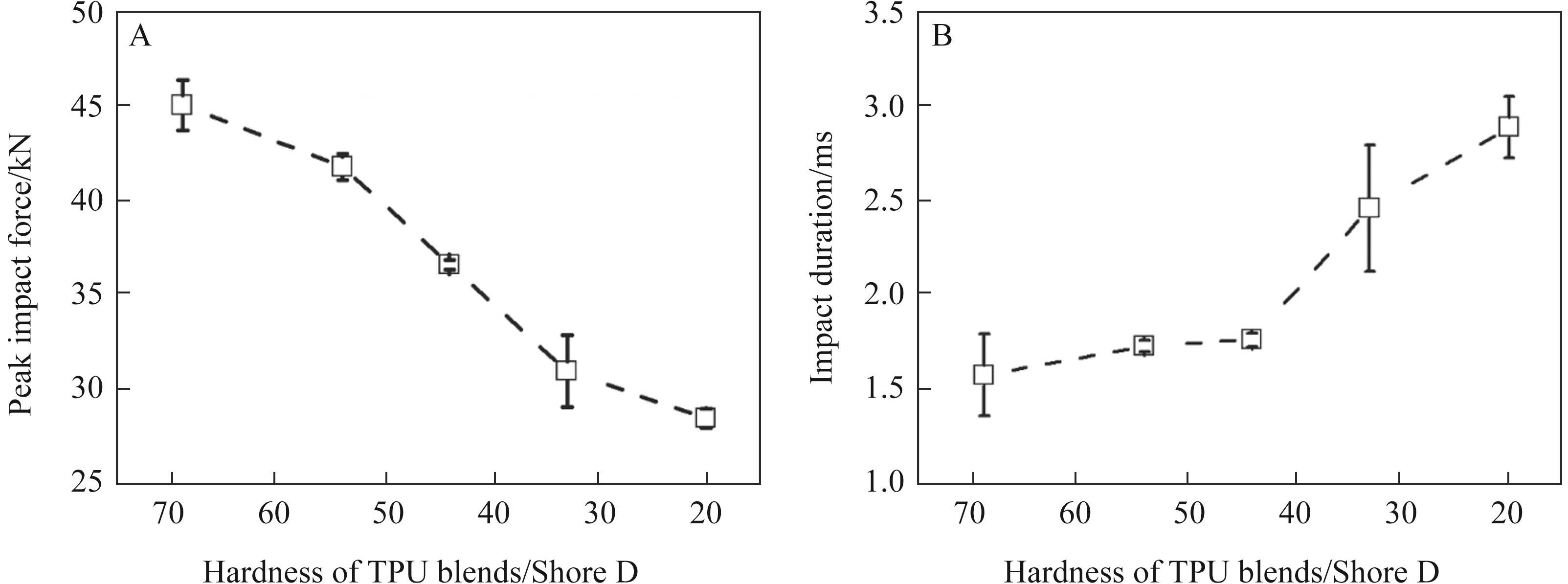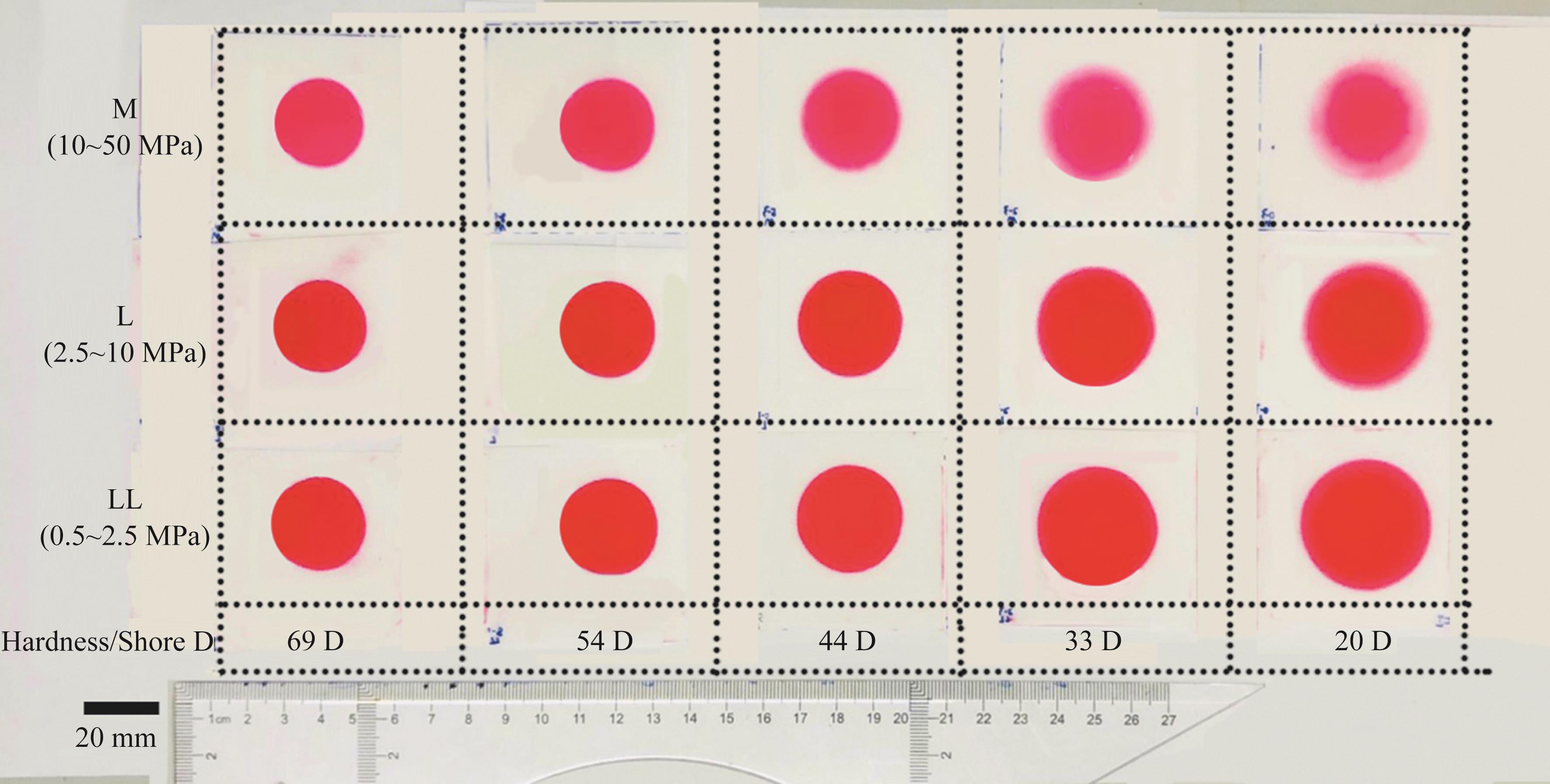
Chinese Journal of Applied Chemistry ›› 2022, Vol. 39 ›› Issue (8): 1216-1223.DOI: 10.19894/j.issn.1000-0518.210476
• Full Papers • Previous Articles Next Articles
Relationship Between Hardness and Impact Properties of Thermoplastic Polyurethane Blends
Dan ZHANG1,2, Fang LIU2, Xue YANG2, Dong-Hua XU2( ), Tong-Fei SHI1,2(
), Tong-Fei SHI1,2( )
)
- 1.Xinjiang Laboratory of Phase Transitions and Microstructures in Condensed Matters,College of Physical Science and Technology,Yili Normal University,Yining 835000,China
2.State Key Laboratory of Polymer Physics and Chemistry,Changchun Institute of Applied Chemistry,Chinese Academy of Sciences,Changchun 130022,China
-
Received:2021-09-23Accepted:2022-02-28Published:2022-08-01Online:2022-08-04 -
Contact:Dong-Hua XU,Tong-Fei SHI -
About author:tfshi@ciac.ac.cn
dhxu@ciac.ac.cn
-
Supported by:the National Natural Science Foundation of China(22073093);the Science and Technology Development Project of Jilin Province, China(20200201239JC);the Spark Project of State Key Laboratory of Polymer Physics and Chemistry
CLC Number:
Cite this article
Dan ZHANG, Fang LIU, Xue YANG, Dong-Hua XU, Tong-Fei SHI. Relationship Between Hardness and Impact Properties of Thermoplastic Polyurethane Blends[J]. Chinese Journal of Applied Chemistry, 2022, 39(8): 1216-1223.
share this article
Add to citation manager EndNote|Ris|BibTeX
URL: http://yyhx.ciac.jl.cn/EN/10.19894/j.issn.1000-0518.210476
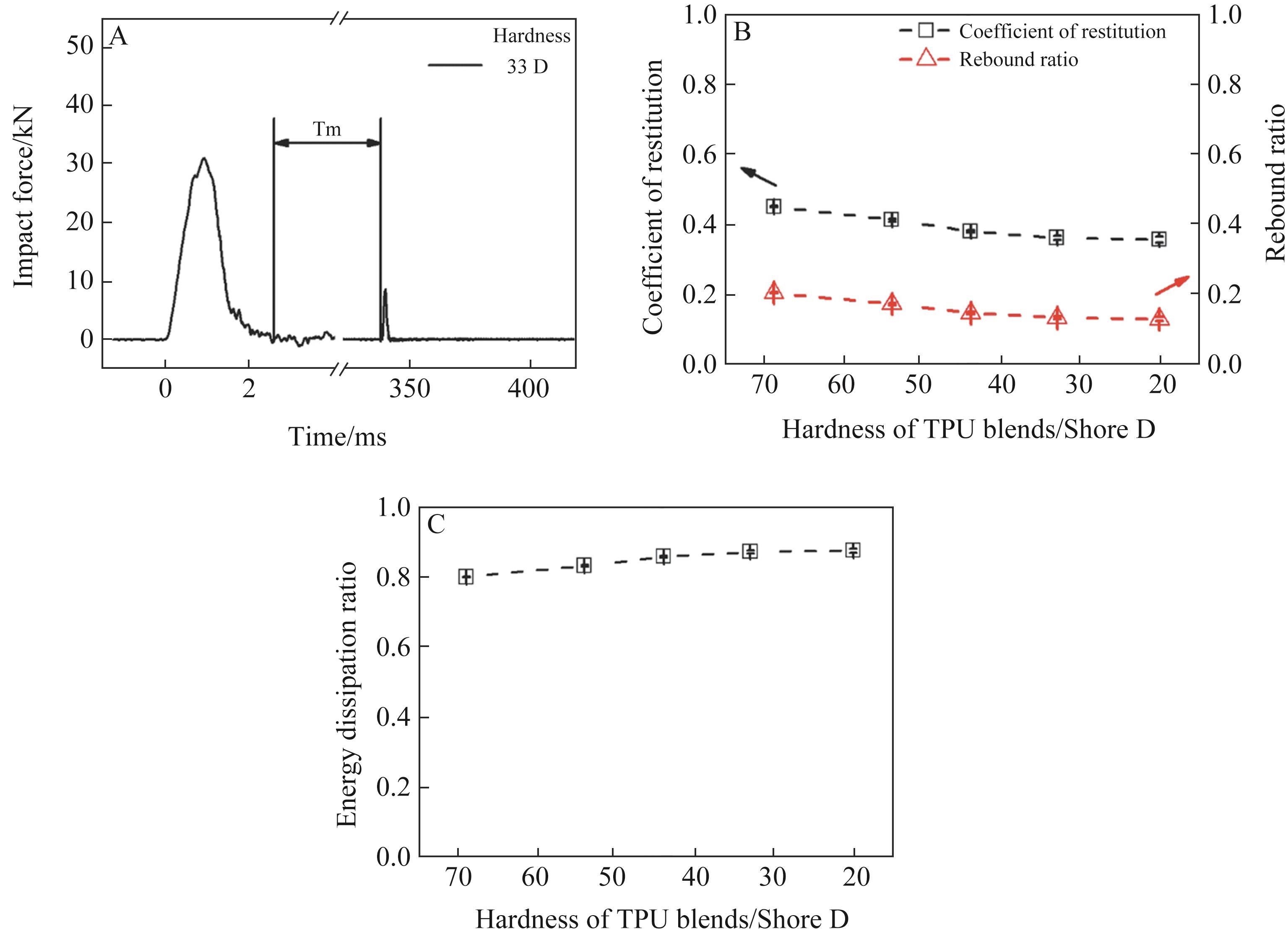
Fig.3 Schematic diagram of Tm selection in formula (1), taking the hardness of 33 D as an example (A), coefficient of restitution, rebound ratio (B) and energy dissipation ratio (C) versus the different hardness of TPU blends
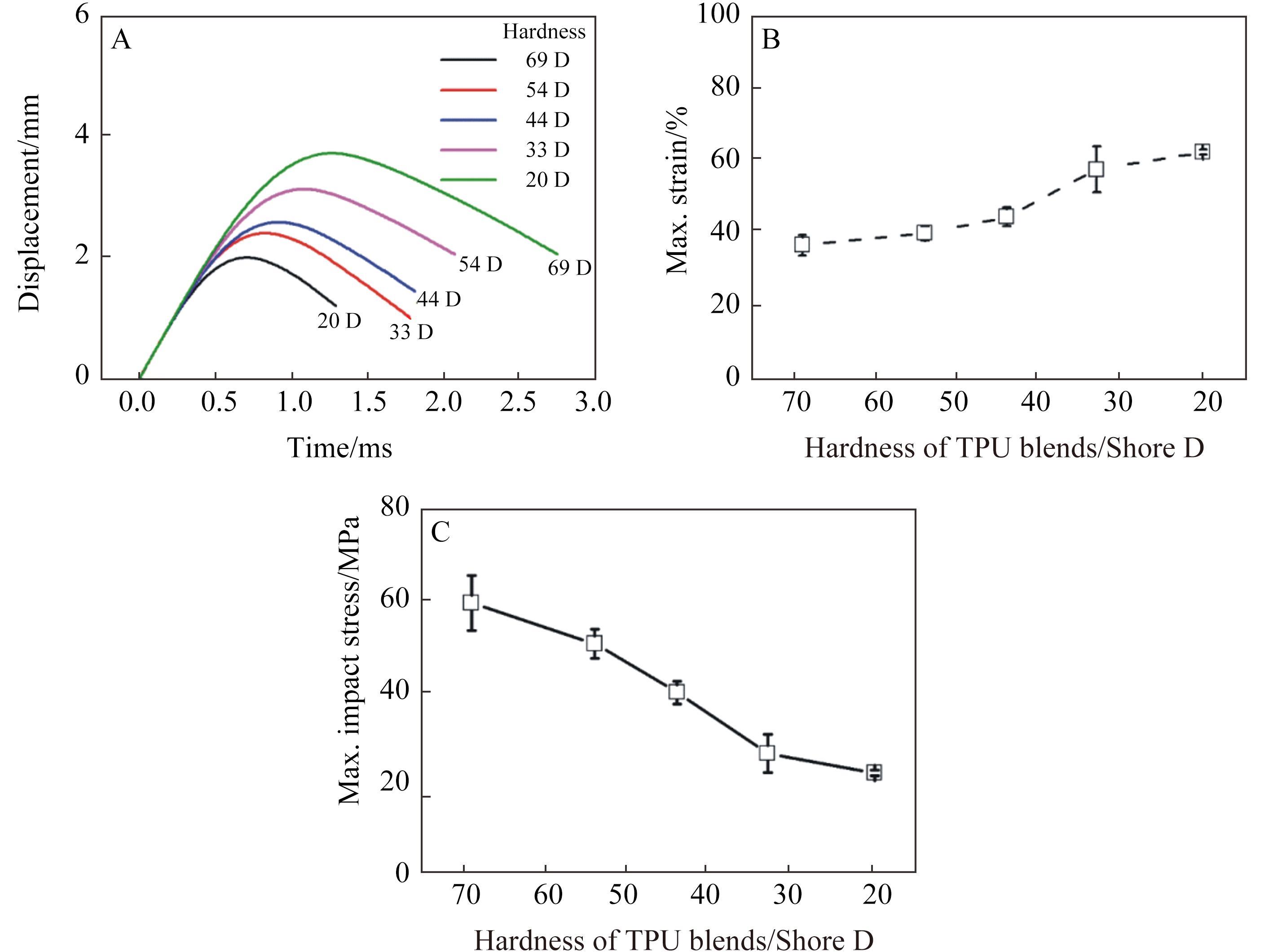
Fig.4 Displacement versus time for the TPU blends with different hardness (A), maximum strain (B) and maximum impact stress(C) of all samples during impact
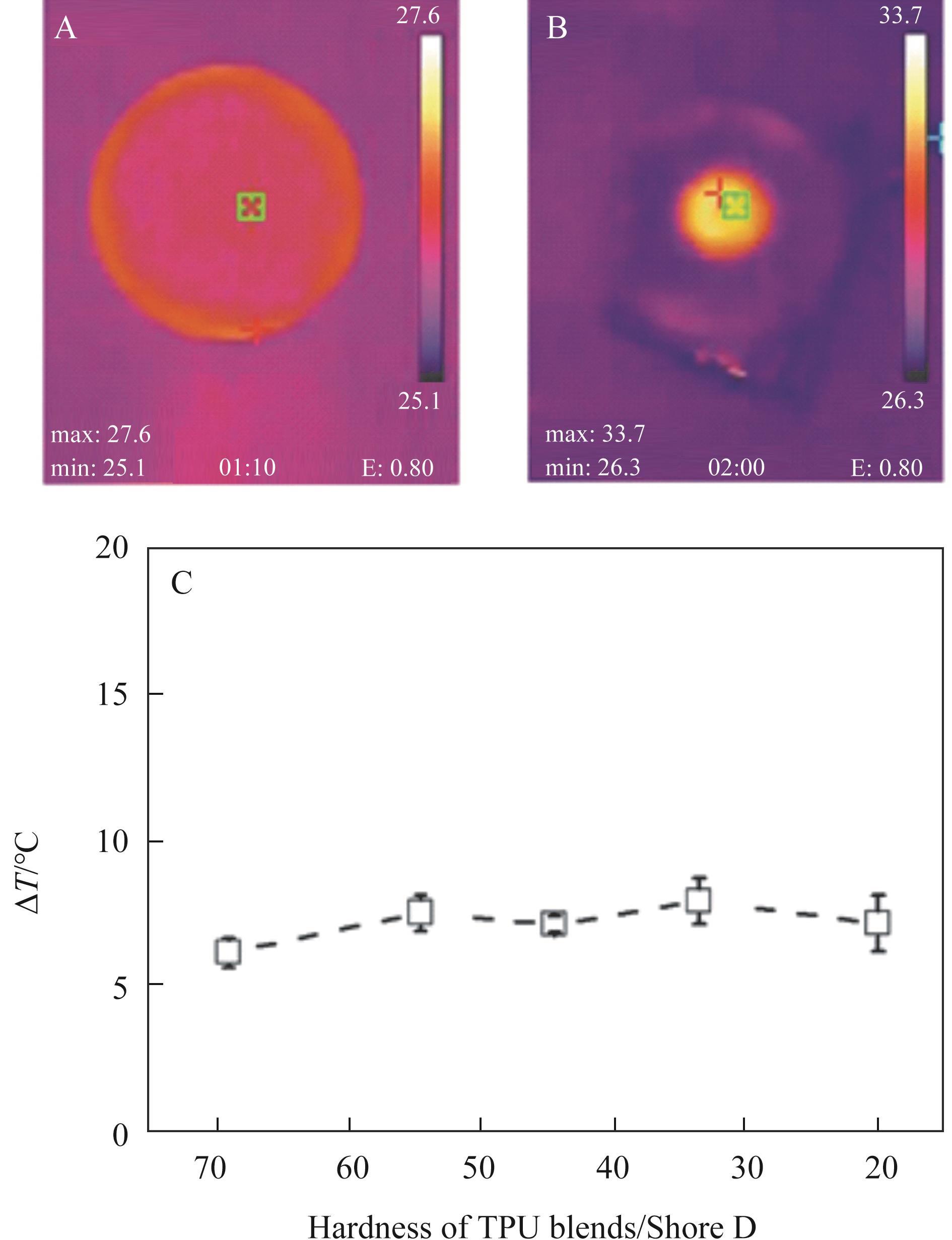
Fig.6 Taking the hardness of 54 D as an example, the sample surface temperature before impact (A), the sample surface temperature after impact (B) and temperature difference of each sample surface after impact and before impact (C)
| 1 | XIANG N, ZHANG X W, ZHENG M Y, et al. Investigation of tensile behavior and molecular structure of the thermoplastic polyurethane sheets injection molded at different mold temperatures[J]. J Appl Polym Sci, 2021, 138(38): 50959. |
| 2 | AHAD N A. A recent blend of thermoplastic polyurethane (TPU)[J]. Mater Sci Eng, 2020, 957(1): 012045. |
| 3 | SATO S, YAMAGUCHI T, SHIBATA K, et al. Dry sliding friction and wear behavior of thermoplastic polyurethane against abrasive paper[J]. Biotribology, 2020, 23(23): 100130. |
| 4 | DATTA J, KASPRZYK P. Thermoplastic polyurethanes derived from petrochemical or renewable resources: a comprehensive review[J]. Polym Eng Sci, 2018, 58(S1): 14-35. |
| 5 | SARALEGI A, RUEDA L, FERNÁNDEZ-D'ARLAS B, et al. Thermoplastic polyurethanes from renewable resources: effect of soft segment chemical structure and molecular weight on morphology and final properties[J]. Polym Int, 2013, 62(1): 106-115. |
| 6 | FENG F, YE L. Morphologies and mechanical properties of polylactide/thermoplastic polyurethane elastomer blends[J]. J Appl Polym Sci, 2011, 119(5): 284-289. |
| 7 | BAJSIĆ E G, ŠMIT I, LESKOVAC M. Blends of thermoplastic polyurethane and polypropylene. I. mechanical and phase behavior[J]. J Appl Polym Sci, 2007, 104(6): 3980-3985. |
| 8 | 管云林, 陈同蕙, 许美萱, 等. 聚碳酸酯改性聚酯型热塑性聚氨酯弹性体的合成与性能[J]. 应用化学, 1994, 11(6): 65-68. |
| GUAN Y L, CHEN T H, XU M X, et al. Synthesis and properties of polycarbonate modified polyester thermoplastic polyurethane elastomer[J]. Chinese J Appl Chem, 1994, 11(6): 65-68. | |
| 9 | SÁNCHEZ-ADSUAR M S, PAPON E, VILLENAVE J J. Influence of the prepolymerization on the properties of thermoplastic polyurethane elastomers. Part I. Prepolymer characterization[J]. J Appl Polym Sci, 2000, 76(10): 1596-1601. |
| 10 | WAN L, DENG C, CHEN H, et al. Flame-retarded thermoplastic polyurethane elastomer: from organic materials to nanocomposites and new prospects[J]. Chem Eng J, 2021, 417: 129314. |
| 11 | CENTELLES X, MARTÍN M, SOLÉ A, et al. Tensile test on interlayer materials for laminated glass under diverse ageing conditions and strain rates[J]. Constr Build Mater, 2020, 243(0): 118230. |
| 12 | CONG K, HE J Y, YANG R J. Using twin screw extrusion reaction (TSER) to produce thermoplastic polyurethane (TPU): tunable, stoichiometric and eco-friendly[J]. Polym Adv Technol, 2021, 32(9): 3495-3504. |
| 13 | MEHRAD A, YUE L, JU T X, et al. Designing thermal annealing to control mechanical performance of thermoplastic polyurethane elastomers[J]. Polymer, 2021, 214: 123254. |
| 14 | WANG S W, SHI M N, YANG W M, et al. Experimental investigation of flame retardancy and mechanical properties of APP/EG/TPU multilayer composites prepared by microlayer coextrusion technology[J]. J Appl Polym Sci, 2020, 138(15): 50219. |
| 15 | PRIMEL A, FÉREC J, AUSIAS G, et al. Solubility and interfacial tension of thermoplastic polyurethane melt in supercritical carbon dioxide and nitrogen[J]. J Supercrit Fluids, 2017, 122: 52-57. |
| 16 | BRÜCKNER K, ODENWALD S, SCHWANITZ S, et al. Polyurethane-foam midsoles in running shoes-impact energy and damping[J]. Procedia Eng, 2010, 2(2): 2789-2793. |
| 17 | 苹果公司. Tech21 Evo Art Botanical Garden 保护壳[EB/OL]. https://www.apple.com.cn/shop/product/HPJS2ZM/A, 2021. |
| APPLE INC. Tech21 Evo Art Botanical Garden protective shell[EB/OL]. https://www.apple.com.cn/shop/product/HPJS2ZM/A, 2021. | |
| 18 | X·ONE公司. 手机防摔壳iPhone系列[EB/OL]. http://www.x-one.cn/product/showproduct.php?lang=cn&id=38, 2021. |
| X·ONE. Mobile phone anti-fall case iPhone series[EB/OL]. http://www.x-one.cn/product/showproduct.php?lang=cn&id=38, 2021. | |
| 19 | 刘必增. 一种TPU手机保护套及其制备方法: 中国, 201410695757.X[P]. 2015-04-29. |
| LIU B Z. TPU mobile phone protective cover and preparation method thereof: CN, 201410695757.X[P]. 2015-04-29. | |
| 20 | 王时民, 何春燕. 全生物降解TPU材料及其制备方法, 及其制成的手机壳: 中国, 201910846672.X[P]. 2019-12-03. |
| WANG S M, HE C Y. Fully biodegradable TPU material and preparation method thereof and mobile phone case made thereof: CN, 201910846672.X [P]. 2019-12-03. | |
| 21 | XU D H, LIU F, PAN G, et al. Softening and hardening of thermal plastic polyurethane blends by water absorbed[J]. Polymer, 2021, 218: 123498. |
| 22 | ZHANG S S, WANG S, HU T, et al. Study the safeguarding performance of shear thickening gel by the mechanoluminescence method[J]. Composites Part B, 2020, 180: 107564. |
| 23 | THIELEN M, SPECK T, SEIDEL R. Impact behaviour of freeze-dried and fresh pomelo (citrus maxima) peel: influence of the hydration state[J]. R Soc Open Sci, 2015, 2(6): 140322. |
| 24 | HUANG H, DALLIMORE M P, PAN J, et al. An investigation of the effect of powder on the impact characteristics between a ball and a plate using free falling experiments[J]. Mater Sci Eng, 1998, 241(1): 38-47. |
| 25 | LOCKETT F J, COUSINS R R, DAWSON D. Engineering basis for selection and use of crash padding materials[J]. Plast Rubber Process Appl, 1981, 1(1): 25-37. |
| [1] | Lin-Tao YANG, Mao LI. Molecular-Mass and Its Distribution Analysis of n-Alkylated Poly(p-phenylene terephthamide) [J]. Chinese Journal of Applied Chemistry, 2023, 40(6): 853-859. |
| [2] | Jia-Cheng ZHOU, Dong-Dong WANG, Yun-Bao GAO, Jing JIN, Wei JIANG. Rheological Properties and Bonding Properties of Modified Poly(Propylene Carbonate) Pressure-sensitive Adhesive [J]. Chinese Journal of Applied Chemistry, 2023, 40(6): 871-878. |
| [3] | Peng-Hui FAN, Jie LIU, Sheng-Hui LOU, Tao TANG. Research Progress on Synergists of Phosphorous Flame Retardants in Epoxy Resin [J]. Chinese Journal of Applied Chemistry, 2023, 40(5): 653-665. |
| [4] | Lin YANG, Hui PAN, Ding-Feng GAO, Xiao-Dong WANG. Preparation and Characterization of Nanocomposite Leather Finishing Agent Based on Aramid Modified Polymer [J]. Chinese Journal of Applied Chemistry, 2023, 40(5): 708-719. |
| [5] | Yu-Chen TAO, Xiao-Hui HOU, Deng-Ke YIN, Ye YANG. Effect of Electric Field-Regulating Cholesterol-based Liquid Crystal Films on the Growth and Differentiation of Fibroblasts [J]. Chinese Journal of Applied Chemistry, 2023, 40(4): 546-553. |
| [6] | Nan-Yu LIN, Feng GAO, Jiang-Ying QU, Jing-Jing TU, Wei-Jun ZHONG, Yun-Hao ZANG. Preparation of Super-hydrophilic/Underwater Oil-phobic High Silicon Cloth and Its Oil-water Separation Performance [J]. Chinese Journal of Applied Chemistry, 2023, 40(3): 449-459. |
| [7] | Bi-Ru SHI, Hao-Hao WU, Hao-Pu XIE, Xin-Xin TIAN, Ying-Lu SUN, Xiang-Dong LIU, Yu-Ming YANG. Preparation and Properties of Self-healing Polyurethane Adhesives with Diels-Alder Bonds [J]. Chinese Journal of Applied Chemistry, 2023, 40(2): 277-287. |
| [8] | Yong-Peng LYU, Yu-Ge WANG, Qian-Qian GU, Zhi-Cai ZHANG, Jian-Shu XIAO, Yuan YIN, Hong-Guo SUN, Ya-Fang ZHENG, Zhao-Yan SUN. Dispersion of Carbon Black in Isoprene Rubber and Its Static and Dynamic Properties [J]. Chinese Journal of Applied Chemistry, 2022, 39(12): 1842-1853. |
| [9] | Yi-Lian MA, Hao-Dong HU, Ying-Li DING, Xiang-Jian CHEN, Liang CUI, Kun-Yu ZHANG. Modification of Polylactic Acid by Reactive Blending with Functionalized Imidazolium-based Ionomers and Epoxy-containing Additives [J]. Chinese Journal of Applied Chemistry, 2022, 39(12): 1870-1879. |
| [10] | Bing-Bing LENG, Chun-Hui ZHU, Cheng-Ying SHI, Zhi-Peng WANG, Yang LIU, Hong-Yan ZHANG, Wen-Ge XU, Bai-Jun LIU. Preparation and Flame Retardancy of the Irradiation‑crosslinked PE‑based Composites Containing a Cyclophosphazene Derivative [J]. Chinese Journal of Applied Chemistry, 2022, 39(11): 1672-1679. |
| [11] | Xu-Kai WANG, Jia-Zhen YANG, Jian-Xun DING. Double Network‑Enhanced Chiral Supramolecular Hydrogel to Promote Osteogenesis [J]. Chinese Journal of Applied Chemistry, 2022, 39(10): 1627-1628. |
| [12] | Xiao-Jian DING, Cong-Jun CAO, Cheng-Min HOU, Han-Xiao MA, Jiao HU, Meng-Jie REN, Guo-Yong YANG. Preparation and Performance of Environmentally Friendly Fluorine⁃Free Superhydrophobic Fabric for Oil/Water Separation [J]. Chinese Journal of Applied Chemistry, 2022, 39(9): 1391-1400. |
| [13] | Xiao-Feng GUO, Jia-Lin LI, Yu-Bo WANG, Jun-Su JIN. Research Progress on Synthesis and Properties of Sulfur⁃Containing High Refractive Index Optical Resins [J]. Chinese Journal of Applied Chemistry, 2022, 39(5): 723-735. |
| [14] | Jing TANG, Na ZHANG, Dong-Xu SHI, Fang-Hui ZHANG, Jian-Jie TANG. Synthesis of UiO-66-NH2Grafted Pyridineimine Cobalt Catalyst and Its Catalytic Performance in Ethylene Oligomerization [J]. Chinese Journal of Applied Chemistry, 2022, 39(02): 258-265. |
| [15] | Jiu-Geng CHENG, Zhao-Hui SU. Quantitative Analysis of Phase Composition of Poly (1-butene) /Polypropylene Blends by Atomic Force Microscopy-Infrared [J]. Chinese Journal of Applied Chemistry, 2022, 39(02): 266-271. |
| Viewed | ||||||
|
Full text |
|
|||||
|
Abstract |
|
|||||
